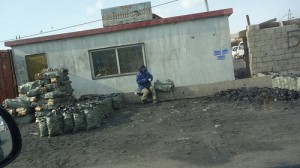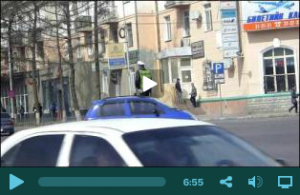I’m running late for my next appointment, and as I rush out of the Grand Khan Irish pub, I look across the sea of cars around Sukhbaatar square, and I cover my mouth with my scarf to try and filter the Coal and Carbon Monoxide filled air. The guide books say UlaanBaatar in winter has some of the worst air quality of any capital city in the world, yet somehow I’ve decided breathing through a scarf will make it all alright.
I know that Susan has been waiting for me for at least 20 minutes in front of the Pink Opera house, and in order to make it there, I’ve still got to negotiate at least two of the the very bizarre intersections that this city has to offer. Since many cars don’t find stop lights compelling enough to obey, I take a certain degree of comfort when I see that not only does this intersection feature traffic police trying to look tough in their sunglasses, but young Mongolians with fluorescent safety vests and mini stop signs. After a long delay, they swing out their arms and start waving the stop signs, in a few cases scolding cars that seem to almost run them down. I blow past the people walking at a normal speed, the tall westerner covered from head to toe in winter gear, using a scarf to cover most of his face and sunglasses to hide his eyes. 25 minutes- I zoom past the very small amount of people at Sukhbaatar Square, tourists perhaps, more people who like me, don’t mind showing up at the tail end of winter.
In front of the Pink Opera house, I find the blue SUV, and there inside is Susan, who to this point I have only spoken on the phone with once. After launching into several apologies, Susan immediately puts me at ease: “No problem. Actually, its nice when people are late, gives me a chance to have a little down time.” — Happy to have some downtime; I love Mongolia.
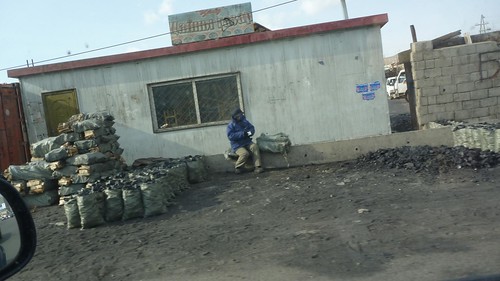
Susan is Project Manager for Flourishing Future*, a non governmental organization working in the Ger (The Mongolian tent many people call Yurts) District. On her business card is the phrase “Helping the Poorest of the Poor” in plain black letter type. Greetings and hello’s being concluded, off we ride through the city center and out to the western side of the city. We drive and talk, my eyes soaking in the rapidly changing cityscape, my mind soaking in the details of what is clearly a very interesting and knowledgeable person. As she explains her relationship to Mongolia, which is more than a decade old, my eyes scan each roadside shack selling bags and bags of coal, wood, car parts, and what I think was scrap metal. Every now and again we pass a line of donkey-pulled carts, waiting to haul heavy loads of wood which I don’t think you’re allowed to carry onto the bus. Susan seems to read the fact that I’m quite taken by what looks like such a different city to when we started, our conversation shifts to what is going on outside and the drunk man that has passed out just as he was crossing the street. Cars drive around him.
A slow left turn and we’re on a dirt road, or at least it seems to be a dirt road, with plenty of craters in it. Susan steers the car towards the side of the road as if we’re pulling over, she explains that we’re not pulling over, but in fact driving on the side of the road or off the road is sometimes smoother than staying on it. As we do this the occasional person walks by us in the opposite direction, unhindered by the potholes. This pseudo road is lined with fences that lead further and further up the mountain, and behind these fences I can see a few very small brick houses and a whole lot of the traditional Gers (or Yurts). It’s the first time I’m this close to this internationally known symbol of nomadic life in Mongolia, and just then it dawns on me-we’ve arrived in the Ger District.
*Link to Rinky Dink Travel, which is associated with Flourishing Future and also took the time to take me around the district.
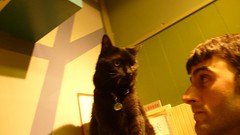 Greetings once again from the neon streets of Tokyo. The TBLI conference is in full swing here and that means yours truely is working hard to make sure technology works during this two day event. Therefore I shall interrupt the serious citizen journalism with a little interlude worthy of the worst and most distracting entertainment websites on the internet today. Yes as of this post, I too am guilty of promoting cat humor.
Greetings once again from the neon streets of Tokyo. The TBLI conference is in full swing here and that means yours truely is working hard to make sure technology works during this two day event. Therefore I shall interrupt the serious citizen journalism with a little interlude worthy of the worst and most distracting entertainment websites on the internet today. Yes as of this post, I too am guilty of promoting cat humor.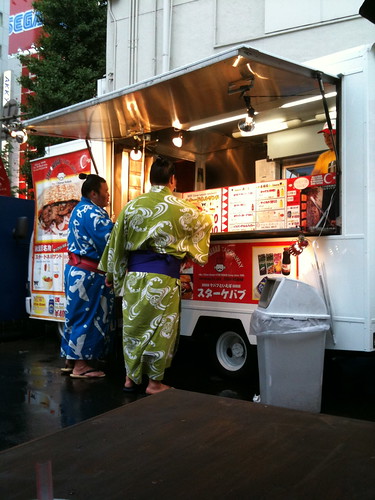 Wandering the streets of Ikebukuro, Shinjuku, Akihabara and beyond, I’m observing a culture and a city that for my entire adult life people have been explaining or trying to describe to me. Yet of course it is one thing to be told about Japan and this crazy capital, yet it is entirely something else to experience it first hand.
Wandering the streets of Ikebukuro, Shinjuku, Akihabara and beyond, I’m observing a culture and a city that for my entire adult life people have been explaining or trying to describe to me. Yet of course it is one thing to be told about Japan and this crazy capital, yet it is entirely something else to experience it first hand. A recent edition of
A recent edition of 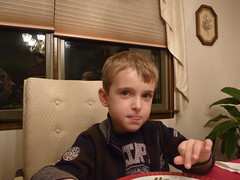 This website has existed in different forms since 2001. In that time, alot of people have come and gone, regular readers, occasional visitors, frequent comment leavers. For those that remember the days when the title of the site was “The Communique” and my focus was on more than under-reported news but also life in Holland, family, friends and internet culture in general, then you’ll surely remember when my nephew A-Ren was born. Its hard to believe 6 years have gone by. To this day when I travel, when I run into friends or aquaintences that know my site, people still ask me “How’s A-Ren?” Naturally I always smile and say He is GREAT!
This website has existed in different forms since 2001. In that time, alot of people have come and gone, regular readers, occasional visitors, frequent comment leavers. For those that remember the days when the title of the site was “The Communique” and my focus was on more than under-reported news but also life in Holland, family, friends and internet culture in general, then you’ll surely remember when my nephew A-Ren was born. Its hard to believe 6 years have gone by. To this day when I travel, when I run into friends or aquaintences that know my site, people still ask me “How’s A-Ren?” Naturally I always smile and say He is GREAT!